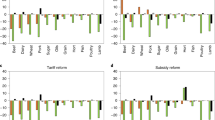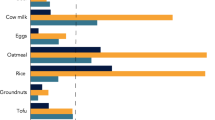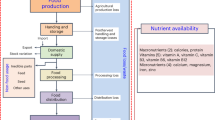Abstract
Food production, dietary choices, climate change, trade tariffs and future responses to the SARS-CoV-2 pandemic are some of the factors affecting global food security. Here we examine how micronutrient security has varied in the United Kingdom from 1961 to 2017, before Brexit, taking supply and demand driver changes into account. We also introduce future scenarios to see how a more plant-based diet and/or differing trade arrangement post-European Union exit and COVID-19 pandemic could affect the supply of nutrients. Results show that trading agreements have affected several key micronutrients during the past 60 years and are likely to be influential in a post-Brexit United Kingdom. Changes in dietary patterns, which influence how much animal- and plant-based products are consumed, have also affected micronutrient security and are likely to do so in the future with increased interest in consuming a more plant-based diet.
This is a preview of subscription content, access via your institution
Access options
Access Nature and 54 other Nature Portfolio journals
Get Nature+, our best-value online-access subscription
$32.99 / 30 days
cancel any time
Subscribe to this journal
Receive 12 digital issues and online access to articles
$119.00 per year
only $9.92 per issue
Buy this article
- Purchase on SpringerLink
- Instant access to full article PDF
Prices may be subject to local taxes which are calculated during checkout




Similar content being viewed by others
Data availability
Source data (HMRC, FAO, McCance and Widdowson) are publicly available and are alternatively available on request from the corresponding authors. Output data derived from MacDiarmid et al. and OTS can be found in Supplementary Data 1.
Code availability
Part of the data analysis was conducted using the R programming language. Further analysis was done in Excel (Supplementary Data 1). R files are available on request from the corresponding authors.
References
Lasko-Skinner, R. & Sweetland, J. Food in a Pandemic (Demos, 2021).
Building better food systems for nutrition and health. Nat. Food (2021) (Sponsor Feature, accessed 21 May 2022). https://media.nature.com/original/magazine-assets/d42473-020-00505-1/d42473-020-00505-1.pdf
Gao, M. et al. Associations between body-mass index and COVID-19 severity in 6.9 million people in England: a prospective, community-based, cohort study. Lancet Diabetes Endocrinol. 9, 350–359 (2021).
McAuliffe, S. et al. Dietary micronutrients in the wake of COVID-19: an appraisal of evidence with a focus on high-risk groups and preventative healthcare. BMJ Nutr. Prev. Health 3, 93–99 (2020).
James, P. et al. The role of nutrition in COVID-19 susceptibility and severity of disease: a systematic review. J. Nutr. 151, 1854–1878 (2021).
Merino, J. et al. Diet quality and risk and severity of COVID-19: a prospective cohort study. Gut 70, 2096–2104 (2021).
Ingram, J. Perspective: look beyond production. Nature 544, S17 (2017).
Hauqe, S. E., Sakisaka, K. & Rahman, M. Examining the relationship between socioeconomic status and the double burden of maternal over- and child under-nutrition in Bangladesh. Eur. J. Clin. Nutr. 73, 531–540 (2019).
Willett, W. et al. Food in the Anthropocene: the EAT–Lancet Commission on healthy diets from sustainable food systems. Lancet 393, 447–492 (2019).
Hirvonen, K., Bai, Y., Headey, D. & Masters, W. A. Affordability of the EAT–Lancet reference diet: a global analysis. Lancet Glob. Health 8, e59–e66 (2020).
Springmann, M. et al. The global and regional costs of healthy and sustainable dietary patterns: a modelling study. Lancet Planet. Health 5, e797–e807 (2021).
Vaidyanathan, G. What humanity should eat to stay healthy and save the planet. Nature 600, 22–25 (2021).
Dimbleby, H. National Food Strategy: independent review - the plan. National Food Strategy (2021).
Food Foundation. Farming for 5-A-Day (2017). https://foodfoundation.org.uk/sites/default/files/2021-10/Farming-for-five-a-day-final.pdf accessed 28 April 2021.
Definition and Classification of Commodities (Food and Agriculture Organization of the United Nations, 2017).
Macdiarmid, J. I., Clark, H., Whybrow, S., de Ruiter, H. & McNeill, G. Assessing national nutrition security: the UK reliance on imports to meet population energy and nutrient recommendations. PLoS ONE 13, e0192649 (2018).
Scheelbeek, P. F. D. et al. United Kingdom’s fruit and vegetable supply is increasingly dependent on imports from climate-vulnerable producing countries. Nat. Food 1, 705–712 (2020).
Scheelbeek, P. F. D. et al. Health impacts and environmental footprints of diets that meet the Eatwell Guide recommendations: analyses of multiple UK studies. BMJ Open 10, e037554 (2020).
Build Back Better: Our Plan for Growth (HM Treasury, 2021).
UK Trade: May 2021 (Office for National Statistics, 2021).
Godfray, H. C. J. et al. Food security: the challenge of feeding 9 billion people. Science 327, 812–818 (2010).
Tilman, D. & Clark, M. Global diets link environmental sustainability and human health. Nature 515, 518–522 (2014).
Khalil, S. & Alexander, S. Shaping the Future of Global Food Systems: A Scenarios Analysis (World Economic Forum and Deloitte, 2017).
Elliott, M. & Bhunnoo, R. Scenarios for transforming the UK food system to meet global agreements. Nat. Food 2, 310–312 (2021).
Baer-Nawrocka, A. & Sadowski, A. Food security and food self-sufficiency around the world: a typology of countries. PLoS ONE 14, e0213448 (2019).
Clapp, J. Food self-sufficiency: making sense of it, and when it makes sense. Food Pol. 66, 88–96 (2017).
Schneider-Petsinger, M. National Self-Sufficiency or Globalization is Not a Binary Choice (Chatham House, 2020).
Poppy, G., Baverstock, J. & Baverstock-Poppy, J. J. Meeting the demand for meat—analysing meat flows to and from the UK pre and post Brexit. Trends Food Sci. Technol. 86, 569–578 (2019).
Factsheet Number 25: Flour Fortification (Federation of Bakers, 2017); https://www.fob.uk.com/wp-content/uploads/2017/01/FS25-Flour-Fortification.pdf
Springmann, M. et al. Health and nutritional aspects of sustainable diet strategies and their association with environmental impacts: a global modelling analysis with country-level detail. Lancet Planet. Health 2, e451–e461 (2018).
Springmann, M., Godfray, H. C. J., Rayner, M. & Scarborough, P. Analysis and valuation of the health and climate change cobenefits of dietary change. Proc. Natl Acad. Sci. USA 113, 4146–4151 (2016).
Food Balance Sheets: A Handbook (Food and Agriculture Organization of the United Nations, 2001); http://www.fao.org/docrep/003/X9892E/X9892E00.HTM
Wood, S., Smith, M. R., Fanzo, J., Remans, R. & DeFries, R. S. Trade and the equitability of global food nutrient distribution. Nat. Sustain. 1, 34–37 (2018).
Geyik, O., Hadjikakou, M. & Bryan, B. Spatiotemporal trends in adequacy of dietary nutrient production and food sources. Glob. Food Sec. 24, 100355 (2020).
Climate Change Vulnerability Index (Verisk Maplecroft, 2016); http://reliefweb.int/sites/reliefweb.int/files/resources/verisk%20index.pdf
Bhunnoo, R. & Poppy, G. A national approach for transformation of the UK food system. Nat. Food 1, 6–8 (2020).
Li-Jing, L. et al. Environmental and economic impacts of trade barriers: the example of China–US trade friction. Resour. Energy Econ. 59, 101144 (2020).
Appleby, T. From membership to partnership: the EU and its relations with the UK after Brexit: the Fisheries dimension. Eur. Foreign Aff. Rev. 25, 551–572 (2020).
Kymäläinen, T., Seisto, A. & Malila, R. Generation Z food waste, diet and consumption habits: a Finnish social design study with future consumers. Sustainability 13, 2124 (2021).
Poppy, G. & Baverstock, J. Rethinking the food system for human health in the Anthropocene. Curr. Biol. 29, R972–R977 (2019).
Living Costs and Food Survey (Office for National Statistics, 2017); https://www.ons.gov.uk/peoplepopulationandcommunity/personalandhouseholdfinances/incomeandwealth/methodologies/livingcostsandfoodsurvey
Population Estimates for UK, England and Wales, Scotland and Northern Ireland (Office for National Statistics, 2017).
Dietary Reference Values for Food Energy and Nutrients in the UK (HMSO, 1991).
The HMRC’s Trade Statistics Database: UKTRADEINFO (HMRC, accessed 24 May 2021); https://www.uktradeinfo.com/
UK Trade Data Visualisation (Food Standards Agency, 2019); https://foodstandards.shinyapps.io/TradeDataVis/
Intrastat Survey (European Trade Center, 2018); http://www.intrastat.ro/di_en.php
McCance, R. A. & Widdowson, E. M. McCance and Widdowson’s The Composition of Foods 7th edn (Royal Society of Chemistry and Public Health England, 2015).
FoodData Central (U.S. Department of Agriculture, 2019); https://fdc.nal.usda.gov/
Melse-Boonstra, A. Bioavailability of micronutrients from nutrient-dense whole foods: zooming in on dairy, vegetables, and fruits. Front. Nutr. 7, 101 (2020).
Serra-Majem, L. et al. Comparative analysis of nutrition data from national, household, and individual levels: results from a WHO-CINDI collaborative project in Canada, Finland, Poland, and Spain. J. Epidemiology Community Health 57, 74–80 (2003).
Whitton, C. et al. National diet and nutrition survey: UK food consumption and nutrient intakes from the first year of the rolling programme and comparisons with previous surveys. Br. J. Nutr. 106, 1899–1914 (2011).
Food Systems Summit (UN, 2021); https://www.un.org/en/food-systems-summit
Acknowledgements
We thank the FSA for access to its data trade visualization app. G.M.P. thanks the FSA for discussions on the future of the UK food system and colleagues in the UK Research and Innovation (UKRI) research community for discussions on food systems and scenario analysis.
Author information
Authors and Affiliations
Contributions
G.M.P., J.B. and J.J.B.-P. jointly designed the study and interpreted the results. J.J.B.-P. conducted the analysis. G.M.P. and J.B. wrote the manuscript with inputs from J.J.B.-P. G.M.P., J.B. and J.J.B.-P. reviewed and edited the manuscript.
Corresponding author
Ethics declarations
Competing interests
The authors declare no competing interests.
Peer review
Peer review information
Nature Food thanks David Salt and the other, anonymous, reviewer(s) for their contribution to the peer review of this work.
Additional information
Publisher’s note Springer Nature remains neutral with regard to jurisdictional claims in published maps and institutional affiliations.
Extended data
Extended Data Fig. 1 Change in micronutrient security between time periods during 1961–2017.
% Changes in key micronutrient security for a range of time periods illustrating changes before joining the EU, immediately after joining the EU and other comparisons from the period 1961–2017. The following micronutrients are plotted: a) vitamin A; b) vitamin C; c) Iron; d) Calcium and e) Zinc.
Extended Data Fig. 2 Micronutrient security scenario plots from 1961–2017.
Micronutrient security from 1961–2017 is plotted on a scenario map where domestic/import and animal/plant are the two uncertainty axes. The following micronutrients are plotted: a) vitamin A; b) vitamin C; c) Iron; d) Calcium and e) Zinc.
Supplementary information
Supplementary information
Codes illustrating the matching of CoFID and HMRC codes.
Supplementary Data
Supplementary data 1: spreadsheet-based data and figures presenting summary data of micronutrient supply and further illustration of nature of the supply source.
Rights and permissions
About this article
Cite this article
Poppy, G.M., Baverstock-Poppy, J.J. & Baverstock, J. Trade and dietary preferences can determine micronutrient security in the United Kingdom. Nat Food 3, 512–522 (2022). https://doi.org/10.1038/s43016-022-00538-3
Received:
Accepted:
Published:
Issue date:
DOI: https://doi.org/10.1038/s43016-022-00538-3
This article is cited by
-
Microbes-Mediated Zinc Biofortification in Tomato Plants Under Ag and TiO2-NP Stress
Journal of Soil Science and Plant Nutrition (2024)
-
Sources of micronutrient supply in the UK
Nature Food (2022)



